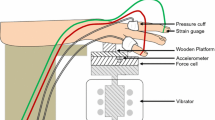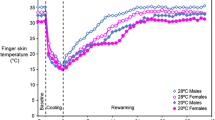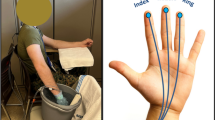Abstract
Objective: To investigate the influence of room temperature on finger blood flow (FBF) change in healthy subjects exposed to short-term grasping of a vibrating handle under different room temperatures. Methods: FBF was measured using a blood flowmeter in six male subjects on the dorsum of the middle phalanx of third finger in both hands once at the end of every minute for an equal duration of 5 min at pre-exposure, during exposure to grasping of vibrating handle with sinusoidal vibration and after exposure. Vibration was generated with a frequency of 125 Hz and an rms acceleration of 40 m/s2. Measurements were conducted in four room temperatures of 15±1, 20±1, 25±1 and 30±1°C. Results: Compared with the baseline measurements in the exposed hand during grasping of vibrating handle most significant increase in FBF was observed at 15±1°C (P<0.001) and least at 30±1°C (P<0.05), and after vibration least significant FBF was found at 25±1°C (P<0.05). In case of the unexposed hand significant increase in FBF was exhibited at 20±1°C (P<0.01) and 30±1°C (P<0.01) during vibration, and only at 15±1°C (P<0.05) after vibration. Conclusions: Response in FBF due to grasping of vibrating handle was of different patterns from the baseline measurement under different room temperature conditions in both exposed and unexposed hands and it was influenced by room temperature. Overall, the influence was greater at lower test room temperature, inducing more significant increase in FBF.





Similar content being viewed by others
References
Azuma T, Ohhashi T, Sakaguchi M (1980) An approach to the pathogenesis of “white finger” induced by vibratory stimulation: acute but sustained changes in vascular responsiveness of canine hindlimb to noradrenaline. Cardiovasc Res 14:725–730
Bornmyr S, Castenfors J, Evander E, Olsson G, Hjortsberg U, Wollmer P (2001) Effect of local cold provocation on systolic blood pressure and skin blood flow in the finger. Clin Physiol 21:570–575
Bovenzi M, Franzinelli A, Scattoni L, Vannuccini L (1994) Hand-arm vibration syndrome among travertine workers: a follow up study. Occup Environ Med 51:361–365
Bovenzi M, Lindsell CJ, Griffin MJ (1998) Duration of acute exposures to vibration and finger circulation. Scand J Work Environ Health 24:130–137
Bovenzi M, Welsh AL, Griffin MJ (2004) Acute effects of continuous and intermittent vibration on finger circulation. Int Arch Occup Environ Health 77:255–263
Egan CE, Espie BH, McGrann S, McKenna KM, Allen JA (1996) Acute effect of vibration on peripheral blood flow in healthy subjects. Occup Env Med 53:663–669
Ekenvall L, Lindbland LE (1986) Is vibration white finger a primary sympathetic nerve injury? Br J Ind Med 43:702–706
Fox RH, Edholm OE (1963) Nervous control of the cutaneous circulation. Br Med Bull 9:110–114
Furuta M, Sakakibara H, Miyao M, Kondo T, Yamada S (1991) Effect of vibration frequency on finger blood flow. Int Arch Occup Environ Health 63:221–224
Futatsuka M, Ueno T, Sakurai T (1985) Follow up study of vibration induced white finger in chain saw operators. Br J Ind Med 42:267–271
Griffin MJ (1997) Measurement, evaluation, and assessment of occupational exposures to hand-transmitted vibration. Occup Environ Med 54:73–89
Harada N, Iwamoto M, Laskar MS, Hirosawa I, Nakamoto M, Shirono S, Wakui T (1998) Effects of room temperature, seasonal condition and food intake on finger skin temperature during cold exposure test for diagnosing hand-arm vibration syndrome. Ind Health 36:166–170
ISO/FDIS 14835- Part 1 (2005) Mechanical vibration and shock – Cold provocation tests for the assessment of peripheral vascular function-Part 1: Measurement and evaluation of finger skin temperature
ISO/FDIS 14835- Part 2 (2005) Mechanical vibration and shock – Cold provocation tests for the assessment of peripheral vascular function-Part 2: Measurement and evaluation of finger systolic blood pressure
Japanese Ministry of Labour (1975) The procedure of a special medical examination related to workers handling vibrating tools. Japanese Labour Standards Bureau Notification, No. 609 (in Japanese)
Johnson JM, Pergola PE, Liao FK, Kellogg DLJr., Crandall CG (1995) Skin of the dorsal aspect of human hands and fingers possesses an active vasodilator system. J Appl Physiol 78:948–954
Loriga G (1911) Il Lavoro con i martelli pneumatici? Boll Inspett Lavorco 2:35–60
McKenna KM, Blann AD, Allen JA (1994) Vascular responses in chain saw operators. Occup Environ Med 51:366–370
Mirbod SM, Yoshida H, Jamali M, Miyashita K, Takada H, Inaba R, Iwata H (1998) Finger skin temperature and laser-doppler finger blood flow in subjects exposed to hand-arm vibration. Ind Health 36:171–178
Nakamura H, Arizumi M, Okazawa T, Nagase H, Yoshida M, Okada A (1995) Involvement of endothelin in peripheral circulatory change induced by hand-arm vibration. Centr Eur J Public Health 3:27–30
Ogasawara C, Sakakibara H, Kondo T, Miyao M, Yamada S, Toyoshima H (1997) Longitudinal study on factors related to the course of vibration-induced white finger. Int Arch Occup Environ Health 69:180–184
Roddie IC (1983) Circulation to skin and adipose tissue. In: Handbook of Physiology. The Cardiovascular system. Peripheral Circulation and Organ Blood Flow. Am Physiol Soc, Bethesda, sec 2, vol 3, pt 1, chapt 10, pp 285–317
Taylor W, Pelmear PL (1975) Vibration white finger in industry. Academic, London
Welsh CL (1980) The effect of vibration on digital blood flow. Br J Surg 67:708–710
Author information
Authors and Affiliations
Corresponding author
Rights and permissions
About this article
Cite this article
Mahbub, M.H., Inoue, M., Yokoyama, K. et al. Assessment of room temperature influence on finger blood flow response induced by short-term grasping of vibrating handle. Int Arch Occup Environ Health 79, 22–26 (2006). https://doi.org/10.1007/s00420-005-0022-2
Received:
Accepted:
Published:
Issue Date:
DOI: https://doi.org/10.1007/s00420-005-0022-2




